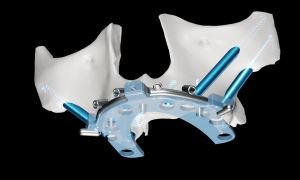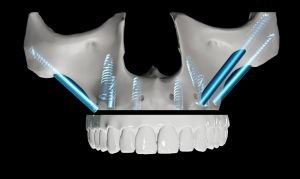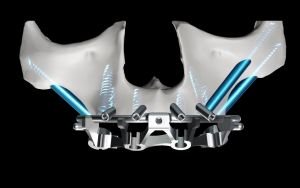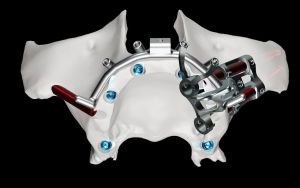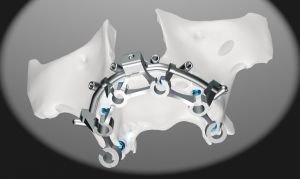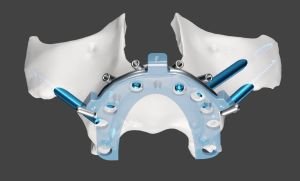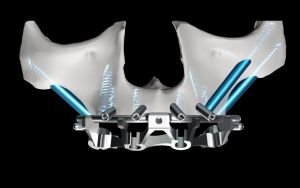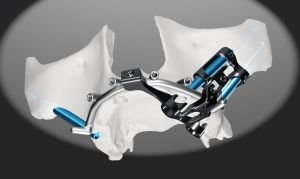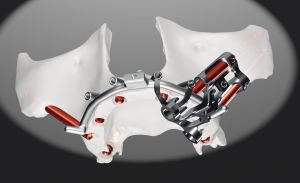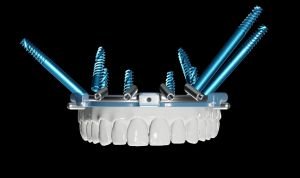Engineering Zygomatic Smiles To Last A Lifetime
Why You May Need Zygomatic Implants
Zygomatic implants are a specialized type of dental implant that can provide a solution for patients who are not candidates for traditional dental implants. If you’ve been told you need zygomatic implants, or if you’re exploring your options for tooth replacement, this guide will help you understand why these unique implants might be recommended for you.
What Are Zygomatic Implants?
Zygomatic implants are longer than traditional dental implants and are anchored in the zygomatic bone (cheekbone) rather than the upper jaw bone. This makes them an excellent option for patients with insufficient bone in the upper jaw to support conventional implants.
Reasons You May Need Zygomatic Implants
1. Severe Bone Loss in the Upper Jaw
- Cause: Long-term tooth loss, periodontal disease, or wearing dentures for many years can lead to significant bone resorption in the upper jaw.
- Why Zygomatic Implants Help: They bypass the area of bone loss by anchoring in the sturdy cheekbone, providing a stable foundation for replacement teeth.
2. Insufficient Bone for Traditional Implants
- Cause: Some patients naturally have thin or soft bone in the upper jaw that can’t support traditional implants.
- Why Zygomatic Implants Help: They offer an alternative that doesn’t rely on the quality or quantity of bone in the upper jaw.
3. Failed Previous Bone Grafts
- Cause: If you’ve had unsuccessful bone grafting procedures in the past, you may not be a candidate for further grafting.
- Why Zygomatic Implants Help: They eliminate the need for extensive bone grafting, offering a solution where traditional methods have failed.
4. Maxillary Sinus Issues
- Cause: Large maxillary sinuses or previous sinus problems can complicate traditional implant placement.
- Why Zygomatic Implants Help: They can often bypass sinus areas, reducing the need for sinus lift procedures.
5. Congenital Defects
- Cause: Some genetic conditions, like ectodermal dysplasia, can result in underdeveloped jaw bones.
- Why Zygomatic Implants Help: They provide a stable option for tooth replacement even when jaw development is incomplete.
6. Trauma or Cancer Resection
- Cause: Accidents or surgical removal of tumors can result in significant loss of jaw bone.
- Why Zygomatic Implants Help: They offer a reconstruction option that doesn’t rely on the remaining jaw bone.
7. Desire to Avoid Bone Grafting
- Cause: Some patients prefer to avoid the additional surgery and healing time associated with bone grafting.
- Why Zygomatic Implants Help: They can often provide a quicker, single-surgery solution for full arch restoration.
8. Need for Immediate Loading
- Cause: Patients who want or need teeth immediately may not be candidates for traditional implants with immediate loading.
- Why Zygomatic Implants Help: The stability provided by anchoring in the cheekbone often allows for immediate placement of a temporary prosthesis.
Benefits of Choosing Zygomatic Implants
- Avoid Bone Grafting: Eliminates the need for extensive and time-consuming bone grafting procedures.
- Faster Treatment: Often allows for a quicker path to your new smile compared to traditional implants with bone grafting.
- High Success Rate: Zygomatic implants have shown excellent long-term success rates in clinical studies.
- Improved Quality of Life: Provides a stable, permanent solution for those who thought they weren’t candidates for implant-supported teeth.
- Aesthetic Results: Supports a full arch of teeth, restoring both function and appearance.
Is This the Right Option for You?
Determining whether zygomatic implants are the best choice for you requires a comprehensive evaluation by a specialized dental team. Advanced 3D imaging and a thorough examination of your oral health and overall medical history will guide this decision.
At [Your Dental Center Name], we use the advanced Precision Zygomatic Smile system to ensure the most accurate and successful placement of zygomatic implants. Our experienced team will guide you through the process, answering all your questions and ensuring you understand why this might be the best solution for your unique situation.
Ready to explore whether zygomatic implants are right for you? Contact us today to schedule a consultation and take the first step towards your new smile!
- Zygomatic implants are an evidence-based surgical and prosthetic solution for both two-stage and immediate loading protocols
- Today, zygomatic implants are usually placed using an immediate loading protocol
- The main indication for zygomatic implants is the severely resorbed edentulous maxilla, but they can also be used in partially edentulous situations
- Indications for zygomatic implant insertion include: alternative for sinus augmentation, failed sinus augmentation, rehabilitation after tumor resection or trauma, failure of conventional implants, failure of previous bone grafts
- The placement of zygomatic implants requires adequate training and surgical experience the Patented Precision Zygomatic Smile System brings unrivaled accuracy and predictability to zygomatic procedures
- Traditional dental implant surgery relies on experience and skill, Precision Zygomatic Smile Technology offers a cutting-edge approach that leverages advanced patented technology for enhanced precision and predictability. This innovative technique utilizes CT scans, Facial Scans, and 3D models of your jawbone and teeth to create a customized surgical plan and specialized Precision Zygomatic Smile System just for you. During the procedure, the Precision Zygomatic Smile System ensures precise implant placement, minimizing the risk of nerve damage and optimizing long-term implant success. Precision Zygomatic Smile Technology can also lead to minimally invasive procedures with faster healing times. This system was developed for dentists and patients who desire preplanned, predictable guided surgical protocols. Precision Zygomatic Smile delivers secured bite verification, secured bone reduction, secured site drilling, accurate secured temporization, and a method of transferring all surgical and restorative information for the final restorative phase.
- Is a revolutionary advancement in comprehensive guided facially driven digital workflows that produces precise, predictable, and pre-engineered new smiles for patients.
- Streamlined Workflow: Precision Zygomatic Smile System simplify the surgical process by allowing for the placement of multiple implants in a single sequence. This can significantly reduce procedure time and improve overall efficiency.
- Enhanced Versatility: The modular design of the Precision Zygomatic Smile System allows for the adaptation to various treatment scenarios, including single implants, full-arch restorations, and complex implant cases.
- Cost-Effectiveness: By minimizing the number of visits required, Precision Zygomatic Smile System can potentially offer better results , more beautiful smiles, and cost-effective solutions for patients.
Benefits of Precision Zygomatic Smile: A Patient’s Perspective
If you’re considering zygomatic implants, you may have heard about the Precision Zygomatic Smile system. This innovative technology is changing the way zygomatic implant procedures are performed, offering numerous benefits to patients. Here’s what you can expect:
1. Increased Accuracy and Predictability
- Customized Treatment: The Precision Zygomatic Smile system uses advanced 3D imaging and planning software to create a treatment plan tailored specifically to your unique facial anatomy.
- Precise Implant Placement: The custom-made surgical guides ensure that your implants are placed exactly where they need to be, increasing the likelihood of a successful outcome.
2. Minimally Invasive Procedure
- Less Surgical Trauma: The precision-guided approach often requires smaller incisions and less tissue manipulation, potentially reducing post-operative discomfort and swelling.
- Faster Recovery: With a less invasive procedure, you may experience a quicker healing process and return to your normal activities sooner.
3. Reduced Treatment Time
- Streamlined Surgery: The pre-planned, guided approach can significantly reduce the time you spend in the dental chair during the procedure.
- Potential for Immediate Results: In many cases, the precision of this system allows for immediate placement of a temporary prosthesis, meaning you could leave your surgery with functional, aesthetic teeth.
4. Improved Comfort
- Less Anxiety: Knowing that your procedure is precisely planned and guided can help alleviate anxiety about the surgery.
- Smoother Experience: The efficiency of the guided surgery often translates to a more comfortable experience during and after the procedure.
5. Optimal Aesthetic Results
- Natural-Looking Smile: The precise planning and placement of implants allow for optimal positioning of your new teeth, resulting in a more natural-looking smile.
- Long-Lasting Results: The accuracy of implant placement can contribute to better long-term stability and aesthetics of your new smile.
6. Increased Confidence in the Procedure
- Visualize Your Results: Advanced planning software often allows you to see a preview of your expected results before the procedure, giving you more confidence in your decision.
- Proven Technology: The Precision Zygomatic Smile system is based on well-established guided surgery principles, providing reassurance about the reliability of the technique.
7. Potential for Complex Cases
- Expanded Possibilities: This precision system may make zygomatic implants a viable option for patients with complex cases who may not have been candidates for traditional approaches.
8. Comprehensive Care
- Team Approach: The Precision Zygomatic Smile system encourages close collaboration between your surgeon, prosthodontist, and dental laboratory, ensuring all aspects of your care are coordinated for the best possible outcome.
Remember, while the Precision Zygomatic Smile system offers many benefits, every patient’s case is unique. Your dental team will discuss whether this approach is right for you and what specific benefits you can expect based on your individual situation.
By choosing a dental center that utilizes the Precision Zygomatic Smile system, you’re opting for a state-of-the-art approach that prioritizes accuracy, comfort, and optimal results in your journey to a new smile.
Complications Avoided with Precision Zygomatic Smile
The Precision Zygomatic Smile system is an advanced technology designed to enhance the safety and success of zygomatic implant procedures. By utilizing this innovative approach, patients can potentially avoid several complications associated with traditional freehand zygomatic implant surgeries. Here’s an overview of the complications that can be minimized or avoided:
1. Implant Misplacement
- Traditional Risk: Imprecise placement of zygomatic implants can lead to suboptimal outcomes.
- How Precision Zygomatic Smile Helps:
- Uses 3D imaging and computer-guided planning for accurate implant positioning
- Custom surgical guides ensure precise implant placement
- Reduces the risk of implants being placed at incorrect angles or depths
2. Sinus Complications
- Traditional Risk: Zygomatic implants pass near or through the maxillary sinus, risking sinus perforation or infection.
- How Precision Zygomatic Smile Helps:
- Provides detailed 3D mapping of sinus anatomy
- Allows for precise planning to avoid unnecessary sinus penetration
- Reduces the risk of sinusitis and other sinus-related complications
3. Nerve Damage
- Traditional Risk: Freehand surgery carries a higher risk of damaging nearby nerves, potentially causing numbness or pain.
- How Precision Zygomatic Smile Helps:
- Accurately maps nerve locations in pre-surgical planning
- Guides implant placement to avoid nerve structures
- Minimizes the risk of postoperative nerve-related discomfort or sensory changes
4. Soft Tissue Complications
- Traditional Risk: Excessive soft tissue manipulation can lead to prolonged swelling, pain, and slower healing.
- How Precision Zygomatic Smile Helps:
- Allows for minimally invasive techniques
- Reduces the need for extensive soft tissue reflection
- Can lead to faster healing and less postoperative discomfort
5. Prosthetic Complications
- Traditional Risk: Improperly positioned implants can lead to difficulties in creating a functional and aesthetic prosthesis.
- How Precision Zygomatic Smile Helps:
- Plans implant positions with the final prosthesis in mind
- Improves the likelihood of achieving optimal prosthetic outcomes
- Reduces the need for prosthetic compromises or adjustments
6. Implant Failure
- Traditional Risk: Improperly placed implants may have a higher risk of failure or loosening over time.
- How Precision Zygomatic Smile Helps:
- Ensures implants are placed in optimal positions for long-term stability
- Improves the distribution of forces on implants
- Can lead to better osseointegration and long-term success rates
7. Unexpected Surgical Complications
- Traditional Risk: Freehand surgery may encounter unexpected anatomical challenges during the procedure.
- How Precision Zygomatic Smile Helps:
- Provides comprehensive pre-surgical planning
- Allows the surgical team to anticipate and prepare for potential challenges
- Reduces the likelihood of intraoperative surprises
8. Extended Surgery Time
- Traditional Risk: Longer surgeries increase the risk of complications related to anesthesia and patient fatigue.
- How Precision Zygomatic Smile Helps:
- Streamlines the surgical process through meticulous pre-planning
- Can significantly reduce time spent in surgery
- Potentially reduces risks associated with prolonged anesthesia
While the Precision Zygomatic Smile system significantly reduces these risks, it’s important to note that all surgical procedures carry some level of risk. Your dental team will discuss your specific case and any potential risks or complications during your consultation.
By choosing a dental center that utilizes the Precision Zygomatic Smile system, you’re opting for a state-of-the-art approach that prioritizes safety, precision, and optimal outcomes in your journey to a new smile.
Precision Smile Proprietary Face Scanning System
Precision Smile Facial Scanner
- The Most Beautiful Natural Smile
- Provides an accurate scan of your face and teeth eliminating the need for fiducial markers, bite forks, and analog facebow.
- Allows for facially driven 3D designed smiles that will look exactly like the design in the frontal and transverse planes, midline, teeth size, and shape, the curve of Speed/Wilson, and smile line.
- Because bite forks are not necessary when using the Precision Smile Facial Scanner, we can capture your bite in any vertical. This is a huge benefit because it allows the restoration to be designed and restored with minimal adjustments. And with such a large field of view, having space between teeth is not an issue, especially compared to conventional workflows.
- NO verification jigs
- NO bite registrations needed at surgery
- NO wax try-ins
- NO midlines that are off-centered
- NO more canted smiles
- NO grinding in the occlusion
- NO facebows or 2D photos necessary
- NO implant impressions at the time of surgery

Precision Smile Facial Scanner
- The Most Beautiful Natural Smile
- Provides an accurate scan of your face and teeth eliminating the need for fiducial markers, bite forks, and analog facebow.
- Allows for facially driven 3D designed smiles that will look exactly like the design in the frontal and transverse planes, midline, teeth size, and shape, the curve of Speed/Wilson, and smile line.
- Because bite forks are not necessary when using the Precision Smile Facial Scanner, we can capture your bite in any vertical. This is a huge benefit because it allows the restoration to be designed and restored with minimal adjustments. And with such a large field of view, having space between teeth is not an issue, especially compared to conventional workflows.
Example 1
Example 2
Example 3
They are longer and tilted at an angle into the cheekbone, or zygoma bone, instead of the jawbone, to provide a more stable foundation for the implant:
- Don’t have enough bone in their upper jaw for traditional implants
- Have been told they aren’t candidates for implants or bridges
- Need significant grafting before implant placement
- Have moderate, advanced, or extreme resorption in the upper jaw
- Increased stability
- Improved aesthetics
- Reduced treatment time
- Improved quality of life
- Less invasive than alternatives
- Stronger, more solid support
- Higher eligibility rate
- Fewer visits from start to finish
- Higher success rate than grafts alone
Recovery time after zygomatic implant placement is typically shorter than traditional implants, and patients can return to normal activities within a few days. However, the implants need time to heal and integrate with the bone, which usually takes several months.
The most common complication associated with zygomatic implants is sinusitis, but appropriate pre-surgical diagnostics and evaluation of the sinus can help reduce or eliminate this complication.
Advantages of Zygomatic Implants
No Bone Grafting Required
- Patients with upper jaw bone loss required bone grafts to maintain their dental implants in position prior to the introduction of zygomatic implants. Unfortunately, it used to take six to twelve months for bone grafts to heal before dental implants could be implanted.
- However, in the case of zygomatic implants, bone grafting is not required (graft-less technique / zero graft technique), so the patient can have a new, beautiful smile as soon as the implantation surgery is completed.
No Need for Sinus Lifts
- Some individuals may require a sinus lift operation prior to Implant placement techniques
- if the upper jaw loses bone mass. Sinus lift surgery strengthens the bone between the mouth cavity and the sinus so that implants do not injure the sinus cavity.
- Patients must then wait for many months for the area to heal before receiving their new teeth. Because zygomatic implants do not require a sinus lift procedure, the implant procedure is simplified and quick.
Enjoy New Teeth Right Away
- Because zygomatic implants are guided straight into the cheekbone, they can be inserted immediately. These implants provide immediate biting ability when involving hard food. Having new teeth quickly can boost self-confidence, along with good-looking teeth and a smile. If a patient has zygomatic implants, they do not need to wait for healing!
Can Be Used in Conjunction with Traditional Implants
- In addition to conventional implants, zygomatic implants can be used to replace teeth both in the upper and lower jaws.
High Success Rate
- The success rate of zygomatic implants is higher than 97%, which is comparable to that of standard dental implants. It also involves less discomfort for patients.
KEY POINTS
- Zygomatic implants are an evidence-based surgical and prosthetic solution for both two-stage and immediate loading protocols
- Today, zygomatic implants are usually placed using an immediate loading protocol
- The main indication for zygomatic implants is the severely resorbed edentulous maxilla, but they can also be used in partially edentulous situations
- Indications for zygomatic implant insertion include: alternative for sinus augmentation, failed sinus augmentation, rehabilitation after tumor resection or trauma, failure of conventional implants, failure of previous bone grafts
- The placement of zygomatic implants requires adequate training and surgical experience


